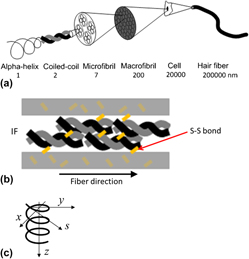Article contents
Mechanics of trichocyte alpha-keratin fibers: Experiment, theory, and simulation
Published online by Cambridge University Press: 15 January 2015
Abstract

The mechanical behavior of human hair is determined by the interaction of trichocyte alpha keratin protein, matrix, and disulfide bonds crosslinking. Much effort has been spent to understand the link between the microscopic structure and the macroscopic fiber properties. Here we apply a mesoscopic coarse-grained model of the keratin macrofilament fibril combined with an analytical solution based on the concept of entropic hyperelasticity of the protein helix to investigate the link between the microscopic structure and the macroscopic properties of keratin fibers. The mesoscopic model provides good agreement with a wide range of experimental results. Based on the mesoscopic model, the predicted stress–strain curve of hair fibers agrees well with our own experimental measurements. The disulfide crosslink between the microfibril–matrix and matrix–matrix contributes to the initial modulus and provides stiffening at larger deformation of the trichocyte keratin fibers. The results show that the disulfide bonds reinforce the macrofilament and enhance the robustness of the macrofilament by facilitating the microfilaments to deform cooperatively. The availability of a mesoscopic model of this protein opens the possibility to further explore the relationship between microscopic chemical structure and macroscopic performance for a bottom-up description of soft materials.
- Type
- Articles
- Information
- Journal of Materials Research , Volume 30 , Issue 1: Focus Issue: Soft Nanomaterials , 14 January 2015 , pp. 26 - 35
- Copyright
- Copyright © Materials Research Society 2015
References
REFERENCES
- 12
- Cited by




